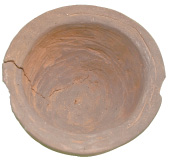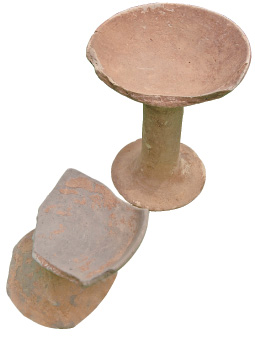
|
An archaeologist cleans the surface of an excavation site at Hujiaying village in Yanqing county on Friday. Photos by Zhang Tao / China Daily |

An accidental find on a routine dig on the outskirts of the capital led to rare discoveries, Qin Zhongwei discovers.
More Chinese today are obsessed with watching history-themed TV soap operas or reading best-selling history books to learn about China's rich history. But there is no better way to see history first-hand than to visit an archaeological site.
During a recent visit to a newly discovered archaeological site in Yanqing county, in Beijing's northwestern suburbs, METRO went back more than 2,000 years and saw how people lived their daily lives in ancient China.
Uncovered at Hujiaying village, in Zhangshanying town, Yanqing, the Hujiaying archaeological site contains the ruins of an ancient village, which might be where a tribe lived from the mid- to late-Eastern Zhou period (770 to 256 BC).
The site contains many cultural remains that probably date from that period.
Like many such archaeological discoveries, this one started with an accidental find while a team was conducting a routine archaeological investigation before work was due to began on a road-building project in March. A team member unearthed something special with his Luoyang shovel, a standard tool used in archeological excavations, and the team members soon enlarged the area of the investigation. Before long they had lifted the veil of time on a sizable archaeological site.
On the site are the remains of the foundations of 24 houses, 21 ash pits, where the ancient people dumped their garbage, and 11 kitchen stoves. There are also four ditches still being dug on the site, which has been divided into two excavation grids. Area A has 20 10-square-meter sections and area B on the northern side has six 10-sq-m grids.
According to Cheng Jinlong, director of Yanqing County's Cultural Relic Management Institute, this site is the first one of a village from the Eastern Zhou period to be discovered in suburban Beijing.
"As most of our other discoveries were burial sites, this is a very rare discovery as it records people's living conditions," Cheng said. "Fortunately, the remains are comparatively well preserved."
Most of the house remains uncovered are semi-subterranean, only 1.5 meters deep.

The houses were oval, rectangular or irregular in shape, and about 10 sq m or even smaller in size. The entrances either faced northwest, east or south.
"Although from our former discoveries we know ancient people were tall, these people lived in very narrow spaces and did not even have beds," Cheng said. "They just covered themselves to take a rest."
It is assumed the hut-like shelters used wooden poles to support roofs made of grass and mud, materials that would not have survived the centuries.
According to Cheng, such huts or temporary shelters are more commonly found in the Yellow River or Yangtze River areas. As the winters in Yanqing are much colder than in the south, the archaeologists are trying to find out how these people stayed warm or whether they moved to warmer locations during the winter. It will take time to answer these questions.
Some ruins show that a river ran nearby.
Cheng said that one of the most important reasons for an ancient tribe to settle in a particular location was that it had a water supply nearby.
A rich variety of items has been unearthed at the site, including animal bones, broken pottery utensils, bronze and iron items, as well as some common stone objects, such as axes, knives, balls and peelers.
All these provide information about how the people of that period lived.
From the shapes and styles of the pottery utensils unearthed, it seems the village was influenced by the agriculture of central China, remains of which have been found in downtown Beijing, and the nomadic culture of the minority tribes on the capital's northern borders.
Historically, Yanqing has been more closely linked to the vast area near the Great Wall than to downtown Beijing.
Wei Jian, history professor at Renmin University of China, said this was why Yanqing was at the frontline of the blending of the two cultures.
As well as being well preserved, the latest discoveries fill a gap in the research into the period, according to Wu Jia'an, an expert from the China Cultural Heritage Institute.
"Although what we found are mostly broken pieces, after putting them together they will certainly help make a more complete picture," Jia said.
(China Daily 05/23/2011)